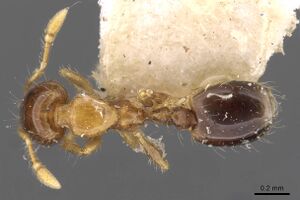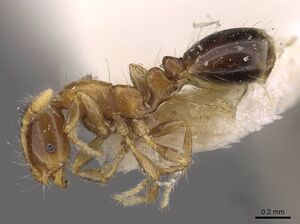Solenopsis altinodis
| Solenopsis altinodis | |
|---|---|

| |
| Scientific classification | |
| Kingdom: | Animalia |
| Phylum: | Arthropoda |
| Class: | Insecta |
| Order: | Hymenoptera |
| Family: | Formicidae |
| Subfamily: | Myrmicinae |
| Tribe: | Solenopsidini |
| Genus: | Solenopsis |
| Species complex: | wasmannii |
| Species: | S. altinodis |
| Binomial name | |
| Solenopsis altinodis Forel, 1912 | |
From Wheeler, W. M. 1921), This species is found with Tachigalia but in the ground and not in petioles. In addition, it can often be found with Coccidotrophus and Eunausibius and destroys the colonies of these organisms. Additionally, this species can be found in ridge forest litter in Costa Rica and was collected at an elevation of 110m in Colombia. It was foraging on the vegetation in Venezuela.
Identification
A New World thief ant that is a member of the wasmannii species complex.
Pacheco and Mackay (2013) – Worker - This species is bicolored with a golden yellow body and a dark brown gaster. The eye is relatively large with 10-12 ommatidia The anterior border of the clypeus is lacking teeth. This species can• be easily recognized by the shape of the petiole. The petiole (side view) is approximately as wide as tall with the anterior edge rounded and lower than the posterior edge.
This species may be confused with Solenopsis bicolor (which overlaps in distribution) based on the anterior clypeal margin and bicolored coloration. However, it can be separated as the petiolar node is unique to this species and thus dissimilar in shape to that of C. bicolor where the petiole is narrow in side view. Additionally, C. bicolor has long erect hairs on all body surfaces and often 0.240 mm in total length on the mesosoma, as compared to the much shorter (0.100 mm) setae present on S. altinodis.
Keys
- Key to New World Solenopsis Species Complexes
- Key to Solenopsis wasmannia species complex / Clave a las obreras del complejo Solenopsis wasmannii
Keys including this Species
Distribution
Latitudinal Distribution Pattern
Latitudinal Range: 9.266667° to 6.684167°.
| North Temperate |
North Subtropical |
Tropical | South Subtropical |
South Temperate |
- Source: AntMaps
Distribution based on Regional Taxon Lists
Neotropical Region: Colombia, Costa Rica, French Guiana, Guyana, Suriname, Trinidad and Tobago, Venezuela (type locality).
Distribution based on AntMaps
Distribution based on AntWeb specimens
Check data from AntWeb
Countries Occupied
| Number of countries occupied by this species based on AntWiki Regional Taxon Lists. In general, fewer countries occupied indicates a narrower range, while more countries indicates a more widespread species. |

|
Estimated Abundance
| Relative abundance based on number of AntMaps records per species (this species within the purple bar). Fewer records (to the left) indicates a less abundant/encountered species while more records (to the right) indicates more abundant/encountered species. |

|
Biology
Castes
Images from AntWeb
   
| |
| Lectotype of Solenopsis altinodis. Worker. Specimen code casent0908808. Photographer Z. Lieberman, uploaded by California Academy of Sciences. | Owned by MHNG, Geneva, Switzerland. |
Known only from the worker caste.
Nomenclature
The following information is derived from Barry Bolton's Online Catalogue of the Ants of the World.
- altinodis. Solenopsis altinodis Forel, 1912g: 10 (w.) VENEZUELA, TRINIDAD.
- Type-material: lectotype worker (by designation of Pacheco & Mackay, 2013: 108), 5 paralectotype workers.
- Type-locality: lectotype Venezuela: Zig Zag (A.Forel) (by restriction of Pacheco & Mackay, 2013: 108); paralectotypes with same data.
- [Note: other original syntype locality: Trinidad: (no further data) (Urich).]
- Type-depository: MHNG.
- Status as species: Wheeler, W.M. 1916d: 324; Wheeler, W.M. 1921f: 154 (redescription); Emery, 1922e: 198; Wheeler, W.M. 1922c: 8; Kempf, 1961b: 508; Ettershank, 1966: 139; Kempf, 1972a: 232; Bolton, 1995b: 386; Pacheco & Mackay, 2013: 107 (redescription); Fernández & Serna, 2019: 815.
- Distribution: Colombia, Costa Rica, Guyana, Trinidad, Venezuela.
- altipunctata. Solenopsis altipunctata Gotzek, et al. 2007: 4, fig. 2. Nomen nudum.
Unless otherwise noted the text for the remainder of this section is reported from the publication that includes the original description.
Description
Worker
Pacheco and Mackay (2013) - Measurements (n=6). TL 1.56-1.80 (1.7); HL 0.444-0.522 (0.483); HW 0390-0.450 (0.410); EL 0.060-0.072 (0.065); ED 0.054; SL 0.276-0.312 (0.292); FSL 0.120; CI 81.3-87.8 (84.9); SI 58.8-62.7 (60.5); PL 0.132-0.168 (0.152); PW 0.096-0.120 (0.111); PI 125.0-147.0 (137.0); PPL 0.120; PPW 0.144-0.156 (0.150); PPI 76.9-83.3 (80.1); WL 0.312-0.360 (0.339); PSL 0.030-0.042 (0.036); PSW 0.024.
Eye relatively large (approximately 10 ommatidia); minor segments of funiculus relatively long; clypeal teeth absent; clypeal carinae extend anteriorly, then abruptly turn inward, passing along anterior margin of clypeus; mesosoma deeply impressed at metanotal suture; area between two faces of propodeum nearly angulate, two faces approximately equal in length; petiole approximately as long from point of dorsum of anterior peduncle, as height from same point to apex, anterior edge rounded, lower than posterior edge, petiole laterally compressed when viewed from above, being narrower anteriorly.
Entire body covered with coarse, erect hairs, approximately 0.1 mm in length.
Type Material
Pacheco and Mackay (2013) - Venezuela, Zig Zag, (lectotype worker [here designated] (Musee d'Histoire Naturelle Genève) and 5 paralectotype workers MHNG).
References
- Forel, A. 1912h. Formicides néotropiques. Part IV. 3me sous-famille Myrmicinae Lep. (suite). Mém. Soc. Entomol. Belg. 20: 1-32 (page 10, worker described)
- Franco, W., Ladino, N., Delabie, J.H.C., Dejean, A., Orivel, J., Fichaux, M., Groc, S., Leponce, M., Feitosa, R.M. 2019. First checklist of the ants (Hymenoptera: Formicidae) of French Guiana. Zootaxa 4674, 509–543 (doi:10.11646/zootaxa.4674.5.2).
- Pacheco, J.A. & Mackay, W.P. 2013. The systematics and biology of the New World thief ants of the genus Solenopsis (Hymenoptera: Formicidae). Edwin Mellen Press, Lewiston, New York. 501 pp.
- Wheeler, W. M. 1921f. The Tachigalia ants. Zoologica (N. Y.) 3: 137-168 (page 154, see also)
References based on Global Ant Biodiversity Informatics
- Achury R., and A.V. Suarez. 2017. Richness and composition of ground-dwelling ants in tropical rainforest and surrounding landscapes in the Colombian Inter-Andean valley. Neotropical Entomology https://doi.org/10.1007/s13744-017-0565-4
- Ettershank G. 1966. A generic revision of the world Myrmicinae related to Solenopsis and Pheidologeton (Hymenoptera: Formicidae). Aust. J. Zool. 14: 73-171.
- Fernández, F. and S. Sendoya. 2004. Lista de las hormigas neotropicales. Biota Colombiana Volume 5, Number 1.
- Forel A. 1912. Formicides néotropiques. Part IV. 3me sous-famille Myrmicinae Lep. (suite). Mémoires de la Société Entomologique de Belgique. 20: 1-32.
- Franco W., N. Ladino, J. H. C. Delabie, A. Dejean, J. Orivel, M. Fichaux, S. Groc, M. Leponce, and R. M. Feitosa. 2019. First checklist of the ants (Hymenoptera: Formicidae) of French Guiana. Zootaxa 4674(5): 509-543.
- INBio Collection (via Gbif)
- Johnson R. Personnal Database. Accessed on February 5th 2014 at http://www.asu.edu/clas/sirgtools/resources.htm
- Kempf W. W. 1961. A survey of the ants of the soil fauna in Surinam (Hymenoptera: Formicidae). Studia Entomologica 4: 481-524.
- Kempf, W.W. 1972. Catalago abreviado das formigas da regiao Neotropical (Hym. Formicidae) Studia Entomologica 15(1-4).
- Weber N. A. 1938. The food of the giant toad, Bufo marinus (L.), in Trinidad and British Guiana with special reference to the ants. Annals of the Entomological Society of America 31: 499-503.
- Wheeler W. M. 1921. The Tachigalia ants. Zoologica (New York) 3: 137-168.
- Wheeler W. M. 1922. The ants of Trinidad. American Museum Novitates 45: 1-16.
- Wheeler, William Morton. 1916. Ants Collected in Trinidad by Professor Roland Thaxter, Mr. F. W. Urich, and Others. Bulletin of the Museum of Comparitive Zoology at Harvard University. 40(8):322-330
